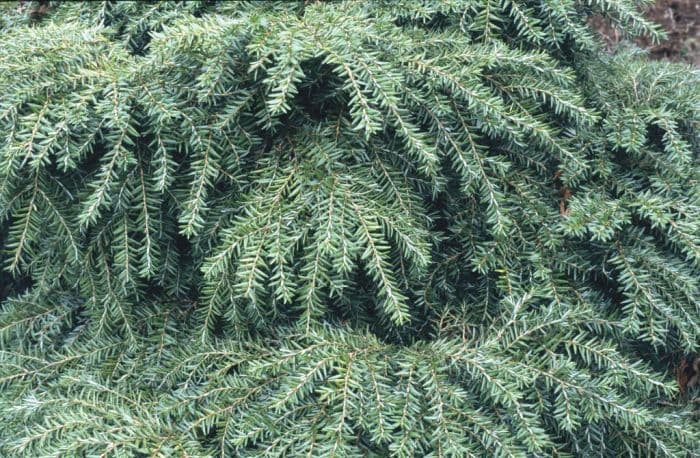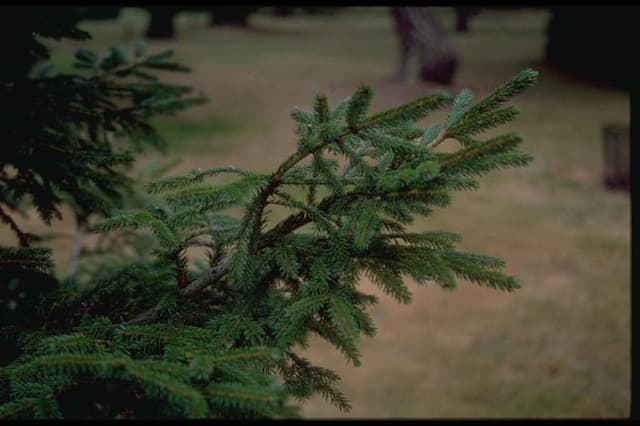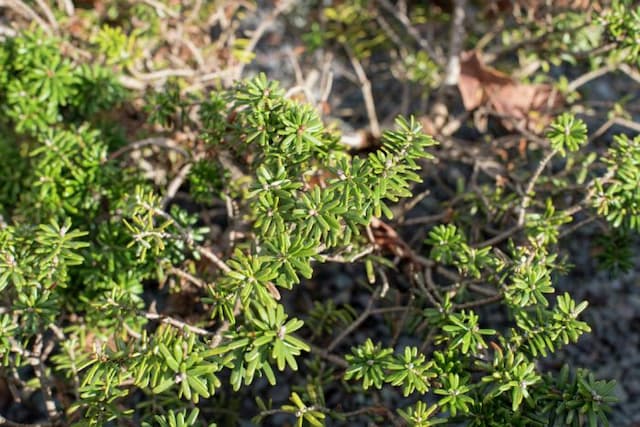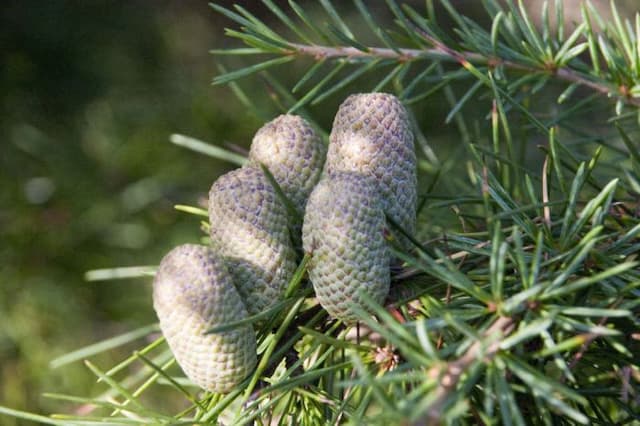Canadian Hemlock Tsuga canadensis 'Jeddeloh'

ABOUT
The Eastern Hemlock 'Jeddeloh' is a gracefully shaped evergreen with distinctive dark green foliage that has a fine texture, perfect for adding an elegant touch to gardens. The needles are small and line the branches in a dense fashion, covering them thoroughly and creating a lush appearance. The plant has a unique, mounded form that dips in the center, giving it a rather nest-like shape particular to this variety. Throughout the year, the rich green color of the foliage provides a beautiful, constant backdrop for other plants in the garden. In contrast to some other evergreen shrubs, the 'Jeddeloh' exhibits a softer, feathery look, which is soothing to the eye and lends itself well to a variety of landscaping themes. This plant's overall habit makes it an appealing choice for those seeking a low-growing, ground-covering specimen that simultaneously offers architectural interest to the landscape.
About this plant
 Names
NamesFamily
Pinaceae.
Synonyms
Jeddeloh Eastern Hemlock, Jeddeloh Canadian Hemlock, Dwarf Weeping Hemlock.
Common names
Tsuga canadensis 'Jeddeloh'.
 Toxicity
ToxicityTo humans
The common name of Tsuga canadensis 'Jeddeloh' is Eastern Hemlock. Eastern Hemlock is not generally considered toxic to humans. However, it is always advisable to exercise caution and avoid ingesting parts of ornamental plants, as individual sensitivity to plants can vary.
To pets
Eastern Hemlock may be toxic to pets if ingested. While cases of poisoning are not frequently reported, the ingestion of plant parts by animals such as dogs and cats could potentially lead to symptoms such as vomiting, drooling, weakness, or difficulty breathing. If you suspect your pet has eaten any part of the plant, consult a veterinarian immediately.
 Characteristics
CharacteristicsLife cycle
Perennials
Foliage type
Evergreen
Color of leaves
Green
Height
3-4 feet (0.91-1.22 meters)
Spread
3-4 feet (0.91-1.22 meters)
Plant type
Shrub
Hardiness zones
3-7
Native area
North America
Benefits
 General Benefits
General Benefits- Aesthetic Appeal: Tsuga canadensis 'Jeddeloh' has a unique, arching shape that provides visual interest in garden landscapes.
- Shade Tolerance: As a member of the Eastern Hemlock family, Jeddeloh thrives in shaded conditions where other plants may fail to grow.
- Evergreen Foliage: Its evergreen nature ensures year-round greenery and structure in the garden.
- Wildlife Habitat: Jeddeloh offers habitat and shelter for birds and other wildlife within its dense foliage.
- Soil Erosion Control: The plant’s root system helps stabilize soil and prevent erosion, especially on slopes.
- Low Maintenance: Requiring minimal care once established, it is an ideal choice for low-maintenance landscaping.
- Size Adaptability: Its smaller, compact size makes it well-suited for smaller gardens or spaces where a full-sized Eastern Hemlock would be too large.
- Drought Resistance: Once established, it can withstand periods of drought, reducing the need for frequent watering.
 Medical Properties
Medical Properties- This plant is not used for medical purposes.
 Air-purifying Qualities
Air-purifying QualitiesThis plant is not specifically known for air purifying qualities.
 Other Uses
Other Uses- Eastern Hemlock 'Jeddeloh' shrubbery can be used in miniature gardening or fairy gardens due to its dwarf form and delicate foliage, providing a perfect dwarf coniferous addition to these whimsical landscapes.
- The dense foliage of Eastern Hemlock 'Jeddeloh' serves as an excellent nesting and sheltering habitat for small birds and wildlife, particularly during harsh weather conditions.
- Eastern Hemlock 'Jeddeloh' is applicable in bonsai art, as its small stature and evergreen nature make it an attractive candidate for bonsai enthusiasts looking to cultivate a forest-style miniature tree.
- Erosion control is another benefit of planting Eastern Hemlock 'Jeddeloh' on slopes and hilly areas, where its root system can help stabilize soil and prevent erosion.
- The wood from Eastern Hemlock 'Jeddeloh' can be used for small woodworking projects, such as crafting birdhouses or garden ornaments, due to its manageable size and wood quality.
- In landscape design, Eastern Hemlock 'Jeddeloh' can act as a soft-textured ground cover in shaded areas, outcompeting weeds and providing evergreen coverage.
- Eastern Hemlock 'Jeddeloh' can be planted in large containers or pots to create a mobile screen or privacy barrier on decks, patios, or balconies.
- Because of its tolerance to shade, Eastern Hemlock 'Jeddeloh' is an ideal candidate for underplanting beneath larger trees where other plants may struggle to grow.
- The thick foliage of Eastern Hemlock 'Jeddeloh' can be used as a natural snow fence in colder regions, reducing snow drift onto paths and driveways.
- For acoustic landscaping, planting Eastern Hemlock 'Jeddeloh' in groups can help dampen noise pollution and create a quieter garden environment.
Interesting Facts
 Feng Shui
Feng ShuiThe Eastern Hemlock is not used in Feng Shui practice.
 Zodiac Sign Compitability
Zodiac Sign CompitabilityThe Eastern Hemlock is not used in astrology practice.
 Plant Symbolism
Plant Symbolism- Longevity and Eternity: Eastern Hemlock, being a conifer that can live for hundreds of years, often symbolizes a long life and eternal aspects of nature.
- Resilience and Strength: Able to survive harsh climates and poor soil conditions, Eastern Hemlock represents resilience in the face of adversity and inner strength.
- Protection and Shelter: Eastern Hemlock, often found providing dense shelter in the forest, can symbolize protection and a safe haven from the outside world.
- Healing and Medicinal Properties: Historically used by native populations for various remedies, the Eastern Hemlock can symbolize healing and the use of natural medicine.
- Adaptability and Flexibility: With its ability to grow in various conditions, Eastern Hemlock represents adaptability to life’s circumstances and flexibility in growth.
 Water
WaterCanadian Hemlock 'Jeddeloh' should be watered deeply and thoroughly, so the water reaches the roots, but it's crucial not to waterlog the soil. In its first growing season, ensure consistent moisture by watering every week with about 1 to 1.5 gallons of water, depending on rainfall and soil drainage. After establishment, reduce the frequency to every two to three weeks, depending on weather conditions. In dry spells, water the same amount every week to keep the soil consistently moist, as Canadian Hemlock does not tolerate drought well.
 Light
LightCanadian Hemlock 'Jeddeloh' thrives in partial shade to full shade. It should be planted in a location where it's protected from the harsh afternoon sun, as too much direct sunlight can scorch its foliage. A spot under the canopy of taller trees or on the north side of a building is ideal, providing protection and filtered light throughout the day.
 Temperature
TemperatureCanadian Hemlock 'Jeddeloh' is cold-hardy and can withstand a range of temperatures, favoring cooler climates. It can survive minimum temperatures as low as -40 degrees Fahrenheit and is comfortable up to 80 degrees Fahrenheit. The ideal temperature range for this hemlock is between 50 and 70 degrees Fahrenheit, which promotes healthy growth without stress from extreme heat or cold.
 Pruning
PruningCanadian Hemlock 'Jeddeloh' requires minimal pruning, mainly to maintain desired shape or to remove any dead or broken branches. The best time to prune is in late winter or early spring before new growth starts. Pruning every 2 to 3 years is often sufficient unless shaping is needed more regularly for hedges or ornamental purposes.
 Cleaning
CleaningNot needed
 Soil
SoilThe Eastern Hemlock prefers moist, well-drained, slightly acidic soil with pH between 5.5 and 6.5; a mix with peat moss and pumice can provide both acidity and drainage.
 Repotting
RepottingThe Eastern Hemlock is typically landscaped outdoors and does not require repotting; however, if grown in a container, repotting every 3-5 years is sufficient.
 Humidity & Misting
Humidity & MistingThe Eastern Hemlock thrives in outdoor environments where natural humidity is present; it does not have specific humidity requirements.
 Suitable locations
Suitable locationsIndoor
Provide bright, indirect light and keep soil evenly moist.
Outdoor
Plant in shade to part-sun in moist soil.
Hardiness zone
3-7 USDA
 Life cycle
Life cycleEastern hemlock 'Jeddeloh' begins its life as a seed, typically germinating in cool, moist soil in shaded conditions. After germination, it enters the seedling stage, developing a root system and juvenile foliage within the first few years. As it matures into the sapling stage, it starts to exhibit its characteristic weeping form and gains height and foliage density. In adulthood, which may take several decades, the tree reaches its full size and starts to reproduce, producing cones that contain seeds for dispersal. Throughout its life, 'Jeddeloh' requires consistently moist, well-drained soil and some protection from harsh winds and sun. The plant can live for several hundred years unless threatened by pests, diseases, or environmental stressors.
 Propogation
PropogationPropogation time
Spring to Summer
The most popular method for propagating the Canadian hemlock 'Jeddeloh' is through semi-hardwood cuttings. This process usually takes place in the late summer. To propagate, a gardener should select healthy, current year's growth that is starting to firm up. Cuttings of about 4 to 6 inches (10 to 15 centimeters) long are snipped just below a node, and the lower needles are removed to expose the nodes. The cut end is often dipped in rooting hormone powder to encourage root development and then placed into a well-draining rooting medium such as a mix of peat and perlite. Cuttings should be kept in a humid environment until roots have developed, which typically takes several weeks to a few months. It's critical to maintain even moisture during this period without saturating the cuttings.









